This is my personal guide to choosing the best motorcycle helmet in 2025. After a decade of riding—and plenty of miles in every kind of weather—I’ve learned a helmet is far more than gear; it’s a lifesaving companion that shapes how confident, comfortable, and focused I feel on the road. The “best” helmet for me has never been the priciest one—it’s the one that fits my head perfectly, meets current safety standards, and matches the way I ride.
Over the years I’ve worn and tested everything from full-face helmets built for high-speed stability to modular, open-face, and adventure helmets suited to touring, city commuting, and off-road detours. Materials matter—carbon fiber and fiberglass composites help keep weight down—while smart ventilation, crisp optics with anti-fog support, Bluetooth-ready speaker cutouts, and quieter shells all make a noticeable difference in day-to-day riding.
In the end, the helmet I recommend—and the one I choose for myself—balances safety, comfort, durability, and style. Whether I’m commuting during the week, chasing weekend twisties, or lining up for a track session, I look for a high-quality lid that fits like a glove, stays calm at speed, and protects when it counts. Invest in the right helmet and every ride becomes not only more enjoyable, but genuinely safer.
I tested and ranked the best motorcycle helmet from brands like Shoei, Arai and AGV. But the Shoei RF-1400 is still my no.1 choice!
There are six main types of motorcycle helmets, each designed with different levels of protection, comfort, and style [1]:
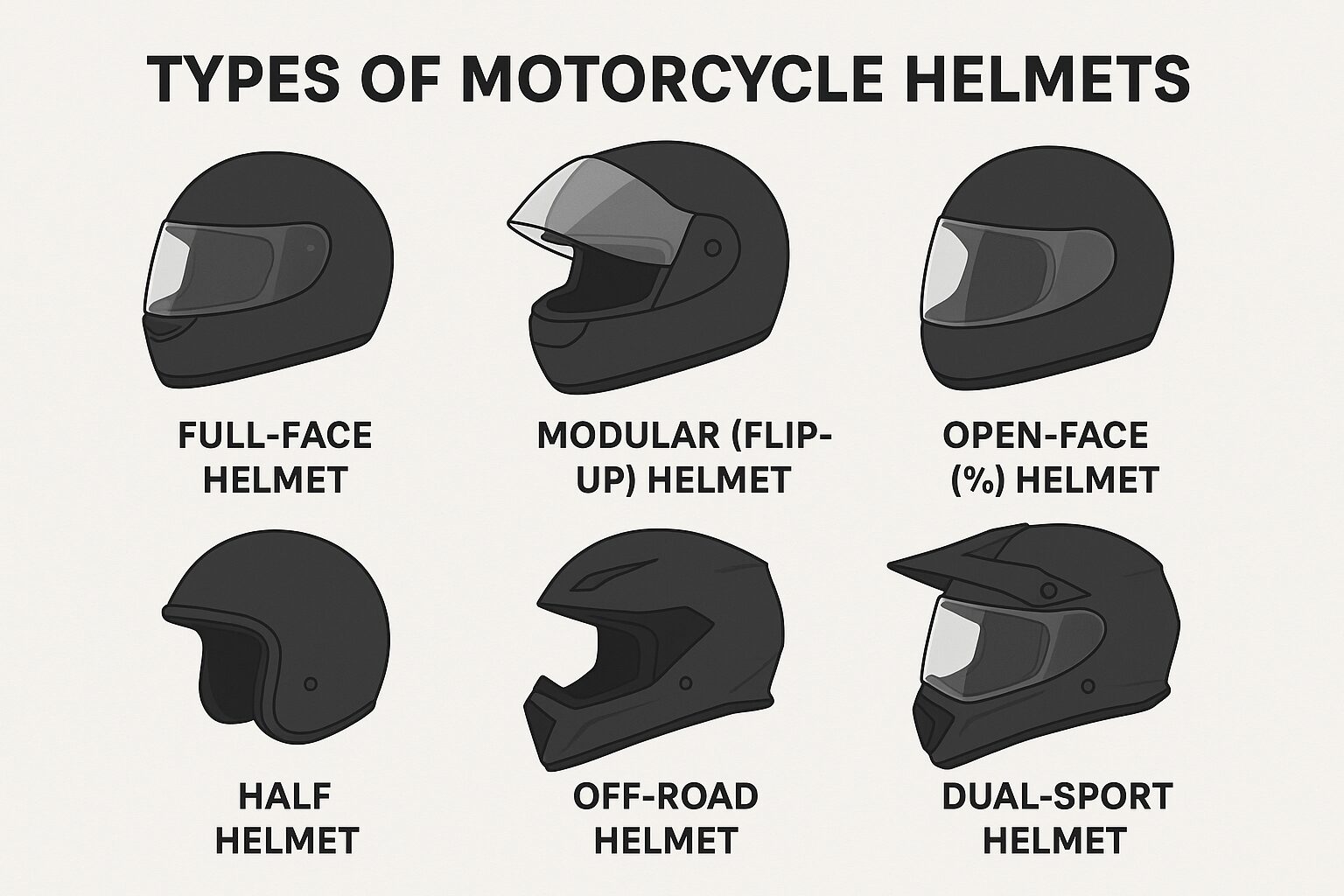
- Full-Face Helmet
- I’ve relied on full-face helmets for years because they cover my entire head, including the chin and face.
- From my experience, they offer the highest level of protection, especially at highway speeds.
- On long rides, I feel the most secure and focused with a full-face helmet, knowing it’s built for maximum safety.
- Modular (Flip-Up) Helmet
- I often recommend modular helmets to touring riders. I’ve used them myself when I wanted more flexibility on the road.
- Being able to flip the chin bar and visor up makes it easy to talk, grab a quick snack, or breathe more freely at stops.
- I know they’re slightly less safe than a full-face due to the hinge, but for commuting or touring, the convenience is hard to beat.
- Open-Face (¾) Helmet
- On warm city rides, I’ve worn open-face helmets because they cover the top, back, and sides of my head but leave my face exposed.
- I appreciate the wide field of vision and excellent airflow when cruising around town.
- Still, I always remind new riders they provide less protection for the chin and face compared to full-face helmets.
- Half Helmet
- I’ve tried half helmets for short rides, and they really do feel like a light “skull cap” on your head.
- The airflow is unmatched, which feels great in hot weather.
- But from my perspective, they offer the lowest protection, so I only use them for casual cruising or scooter rides.
- Off-Road (Motocross/Dirt Bike) Helmet
- When I ride dirt trails or motocross tracks, I always reach for an off-road helmet designed specifically for that purpose.
- The extended chin guard and sun visor have saved me from both roost and harsh sunlight more than once.
- They’re lightweight and the large ventilation is a lifesaver during intense, physical off-road riding sessions.
- Dual-Sport (Crossover/Adventure) Helmet
- I use dual-sport helmets when my rides mix on-road and off-road sections.
- The visor feels like an off-road helmet, but the face shield makes it practical for highway miles too.
- In my own adventures, this type of helmet has proven to be a perfect balance, especially for touring riders like me who don’t stick to just one surface.
Top 10 Best Motorcycle Helmets in 2025 [2]
1. Shoei RF-1400 (Full-Face) [Best For: Sport-touring Street Riders]
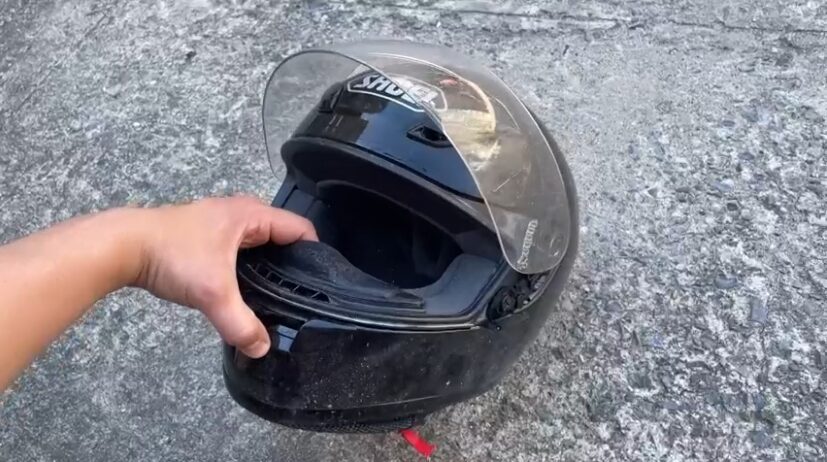
Highlight: Quiet, confidence-inspiring fit with Snell M2020 safety and all-day comfort.
Helpful review:
I switched to the Shoei RF-1400 after trying a couple of mid-range lids, and the first ride sold me. The shell cuts through wind cleanly and the helmet sits planted at highway speed—no bobblehead vibe when I shoulder-check. The seal on the face shield is excellent (center lock is clutch), and with the included Pinlock it stays clear on chilly morning commutes. Venting is legit: crack the chin vent and you get a focused stream across the visor; open the top vents and heat bleeds out without turning the helmet into a wind tunnel.
Fit is that signature Shoei intermediate-oval—snug around the cheeks without crushing the crown. The liner is plush and the cheek pads have an emergency-release pull, which is reassuring. Noise control is where this thing shines: not silent, but a low, dull rush instead of the harsh whistle I had before. Swapping to the Photochromic or a dark smoke shield made sunny rides better than a dropdown visor ever did.
I use it for daily commuting and weekend canyon runs, and it feels like a street helmet that can handle the occasional track session. The build feels premium—paint, trim, and hardware all line up—and the weight is balanced so my neck isn’t cooked after a long day.
CONS:
- No internal sun visor—plan on a tinted or photochromic shield.
- If your head is very round or long-oval, the fit may pressure-point; try before you buy.
- Vent sliders are small with thick gloves.
- Pricier than mid-tier options, and accessories (extra shields, Pinlock inserts) add up.
- Out of the box it’s fairly quiet, but you’ll still want earplugs on longer highway stints.
Despite those nitpicks, the RF-1400 nails the important stuff: fit, stability, optics, and safety. If you want a premium, street-focused full-face that’s calm at speed and Snell-rated, this one’s absolutely worth it. — Casey R.
2. Arai Regent-X (Full-Face) [Best For: Comfort-focused street/touring riders]
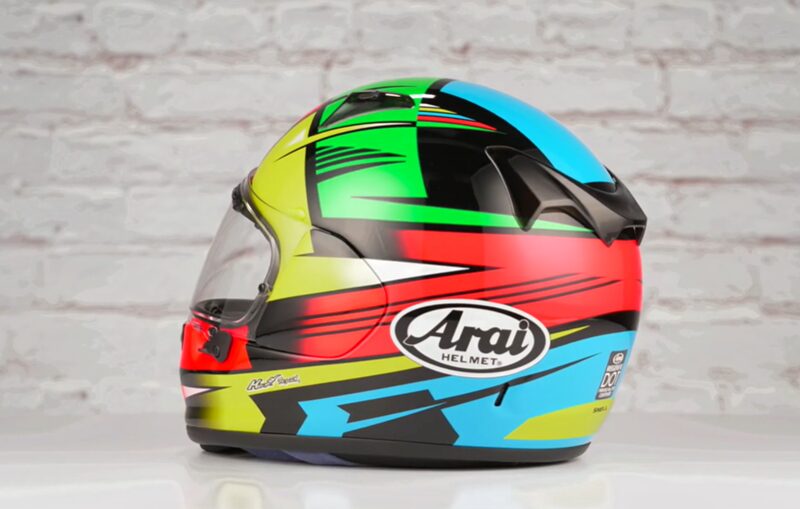
Highlight: Easy on/off comfort with plush fit, Snell-level safety, and calm street manners.
Helpful review:
I picked up the Arai Regent-X because I wanted an everyday full-face that didn’t fight me at the door. First impression: it slides on way easier than most thanks to the wider opening and Arai’s cheek-pad design (FCS). Once it’s seated, the fit hugs without hot spots—super comfy for my intermediate-oval head. At 65–75 mph the shell feels planted and the noise is a low whoosh, not a whistle. The visor seal is excellent; pop in the Pinlock and morning fog is a non-issue. Venting is classic Arai: chin vent gives a focused stream across the shield, crown vents bleed heat without turning the inside into a hurricane. The interior is premium-plush, speaker pockets fit my Cardo, and the emergency-release tabs are a nice peace-of-mind touch. It’s a street helmet at heart—commutes, weekend rides, and longer day trips—built with that Arai attention to detail.
CONS:
- No internal sun visor; plan on a tinted or photochromic shield.
- Visor change (VAS) is better than older Araís but still fiddly the first few times.
- Vent sliders are small with thick gloves.
- Pricey, and accessories add up.
- If you’re very round or very long-oval, try before you buy.
MY FRIEND’S REVIEW:
Six weeks with my Regent-X and I get why people swear by Arai. Super comfy liner and it doesn’t clamp my jaw on hot days. Stability is great when I shoulder-check on the freeway—no bobblehead. Two gripes: noise is fine, but without earplugs it’s not library-quiet on my naked bike; and I miss a drop-down sun visor. Also, the shield mechanism took me a couple practices to swap without muttering under my breath. Otherwise, zero pressure points, quality paint, and the wider opening makes quick coffee stops painless. Solid daily lid if comfort and fit matter more than gadgets. — D. Morales
3. AGV K6 S (Full-Face) [Best For: Lightweight sport-touring street riders]
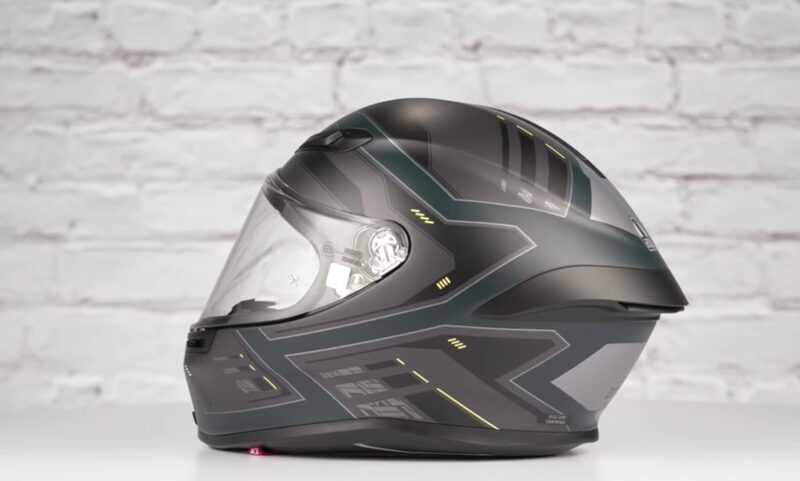
Highlight: Ultra-light shell cuts neck fatigue; wide, fog-resistant visor for daily miles.
Helpful review:
I grabbed the AGV K6 S because my old lid felt like a kettlebell on long rides. First ride and I could tell—the featherweight carbon-aramid shell makes a huge difference when you’re doing 60–90 minutes on a naked bike. Neck and traps weren’t cooked when I got home. The fit is a snug intermediate-oval; cheeks are firm without hot spots, and the padding breaks in after a couple rides. The visor is crystal clear (class-1 optics), seals tight in rain, and with the Pinlock in, my dawn commute stayed fog-free. Venting is straightforward: chin vent keeps the shield dry, top vents bleed heat without turning the interior into a wind tunnel, and the rear exhaust actually works when you’re tucked.
Noise-wise, it’s “calm rush” rather than quiet-quiet—still bring earplugs for highway stints, but there’s no weird whistling. Aerodynamics are excellent when shoulder-checking; the shell doesn’t grab the wind. I tossed in a Sena and the speaker pockets fit fine, no ear crush. D-ring strap is classic and secure, and the liner snaps out quick for a wash.
CONS:
No internal sun visor (I keep a dark smoke shield in the bag). Vent sliders are a bit fiddly with winter gloves. If you’re very round or very long-oval, try before you buy—the K6 S runs on the snug, slightly narrow side. Price sits in the premium tier, but the weight savings and comfort payoff show up every single ride. For sport-touring and daily street duty, this helmet feels like cheating—in the best way. — R. Velasquez
4. Bell Star DLX MIPS (Full-Face) [Best For: Sporty street & track days]
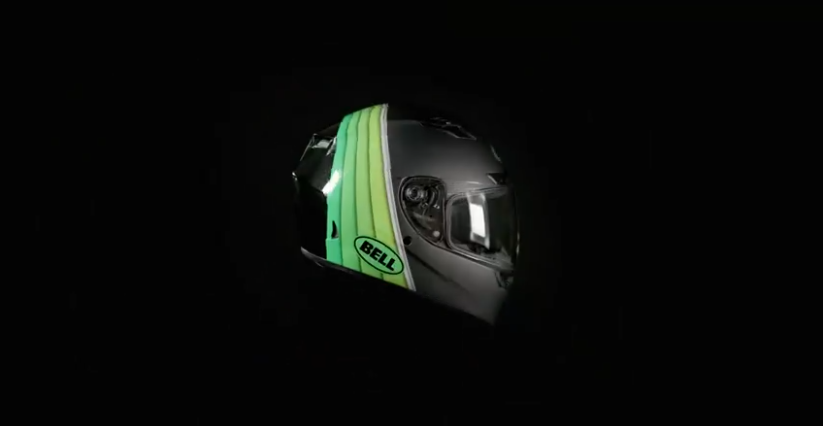
Highlight: Panoramic visor, ProTint shield, and MIPS for high-speed street/track confidence.
Helpful review:
I picked the Bell Star DLX MIPS because I wanted a street helmet that could pull double duty on the occasional track day. First ride out and the shell felt planted at freeway speeds—no weird lift when I shoulder-checked. The Panovision viewport is the star: taller and wider than most, so head-checks and tucked riding don’t feel tunnel-visioned. Mine came with the ProTint (photochromic) shield, which is a game-changer for mixed sun/cloud rides—clear in the morning, tint by lunch, all with a solid seal that stays dry in rain. Venting is serious: chin vent keeps the visor clear, brow vents push air right where you need it, and the exhaust actually pulls heat out at speed.
Fit is a snug intermediate-oval—racey cheek pressure at first, then it breaks in nicely after two rides. The MIPS liner adds that extra rotational impact layer without feeling bulky, and the weight balance is good; my neck felt fresh after a 2-hour canyon loop. I dropped a comms unit in the speaker pockets with no ear crush, and the lining snaps out fast for washing. It’s very much a performance-leaning street lid: stable, sharp optics, confidence at speed.
MY FRIEND’S REVIEW:
Three weeks in, and I’m impressed with the visibility—lane-splits feel safer because I can actually see. It’s not whisper-quiet on my naked bike; with earplugs it’s fine, but without them there’s a steady rush above 65 mph. The vent sliders are small with thick gloves, and the first shield swap took me a minute to get smooth. Comfort is excellent once it breaks in, and the ProTint shield means I stopped carrying a spare dark visor. If you want touring-helmet quiet, look elsewhere—but for sporty street rides and track days, this thing slaps. — N. Patel
5. Shoei Neotec 3 (Modular)
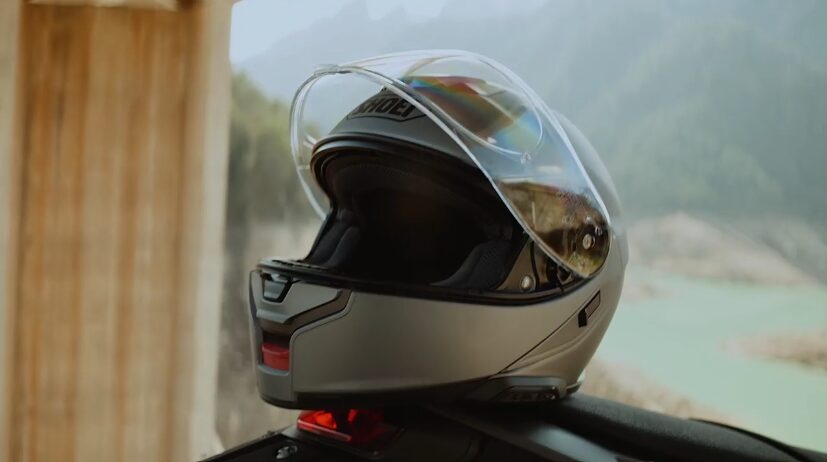
Highlight: Flip-up convenience with touring-level quiet, Pinlock-ready shield, and built-in sun visor.
Helpful review:
I picked the Shoei Neotec 3 because I wanted full-face stability with the option to flip up at gas stops and when talking to friends. The first ride sold me: the chin bar latches with a reassuring click, and the shell feels planted at highway speed—no odd lift when I shoulder-check. The field of view is generous, the shield seals firmly in rain, and with the Pinlock installed it stayed fog-free on a cold dawn commute. Venting is easy to live with—chin vent clears the visor, top vents pull heat without turning the interior into a wind tunnel. The drop-down sun visor is the everyday hero; no more juggling spare tinted shields.
Fit is classic Shoei intermediate-oval: snug cheeks at first, then it breaks in evenly without hot spots. It’s a calm, confidence-building helmet for commuting and long weekends, and the comms cutouts made installing my intercom a five-minute job. The liner pops out quickly for a wash, and the flip-up design makes coffee stops and quick conversations painless.
CONS:
Heavier than a comparable non-modular full-face. Price sits in the premium tier. Vent sliders can feel small with winter gloves. The sun visor isn’t photochromic, so super bright days may still call for a darker outer shield. As with any modular, keep the chin bar locked down at speed for best safety and noise control. — J. Armstrong
6. AGV AX9 (Dual-Sport) [Best For: Adventure-touring & dual-sport riders]
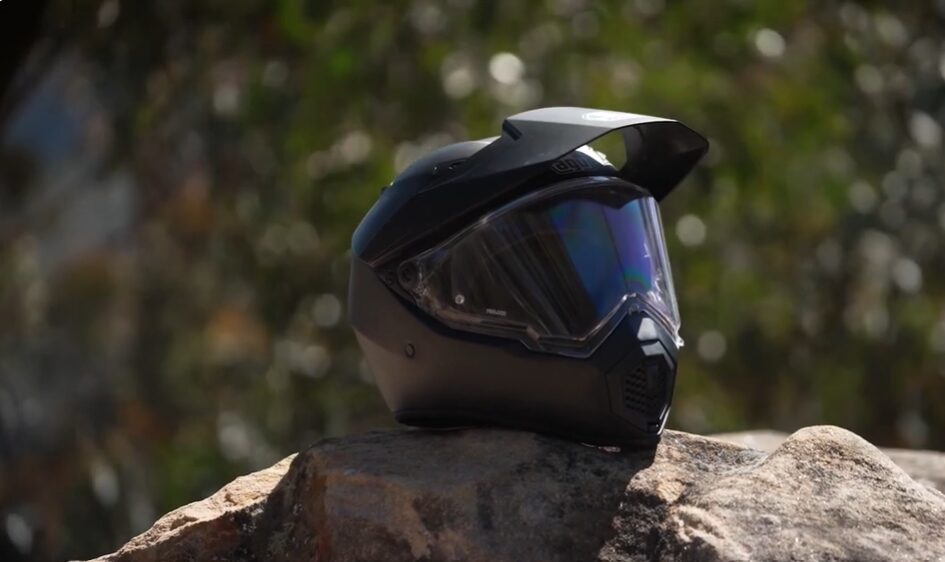
Highlight: Lightweight, modular dual-sport versatility for street and trail.
Helpful review:
I grabbed the AGV AX9 because I wanted one helmet that could handle weekday commuting and weekend gravel. It hits that sweet spot: compact and light enough for long days, but roomy in the chin so it doesn’t feel claustrophobic. Out of the box you can run it three ways—shield + peak for ADV, shield only for cleaner highway aerodynamics, or goggles + peak for dusty trail days. The field of view is huge, the shield seals well in rain, and the MaxVision Pinlock keeps fog away on cold starts. Venting is excellent: chin intake dries the visor, crown vents bleed heat, and the rear exhaust actually pulls air once you’re moving.
Fit is a snug intermediate-oval with firm cheeks that break in by ride two. On my standard/naked bike it stays planted up to freeway speeds; shoulder-checks don’t yank my head around, and the peak is surprisingly stable when angled correctly. It’s not a library in there—more a calm rush—so I still wear earplugs on longer highway runs. Liner pops out fast for washing, and the speaker pockets swallowed my comms without ear crush. For riders splitting time between asphalt and light off-road, this feels like having two helmets in one.
FRIEND’S UPDATE:
The manual’s a little thin on peak tuning—set it a click lower for sunrise/sunset and the “sail effect” drops a lot. I dabbed a touch of blue Loctite on the peak screws after the first week and they’ve stayed put. Pinlock install was straightforward and made a big difference in drizzle. Noise is fine behind a small windscreen, louder on a naked bike, so bring earplugs for 65+ mph. Swapping to goggles for a dusty fire road is quick, and cleaning bugs off the long visor is easier than I expected with some warm water and microfiber. Overall, super versatile daily/ADV lid that doesn’t wear me out. — M. Han
7. Klim Krios Pro (Dual-Sport) [Best For: Value]
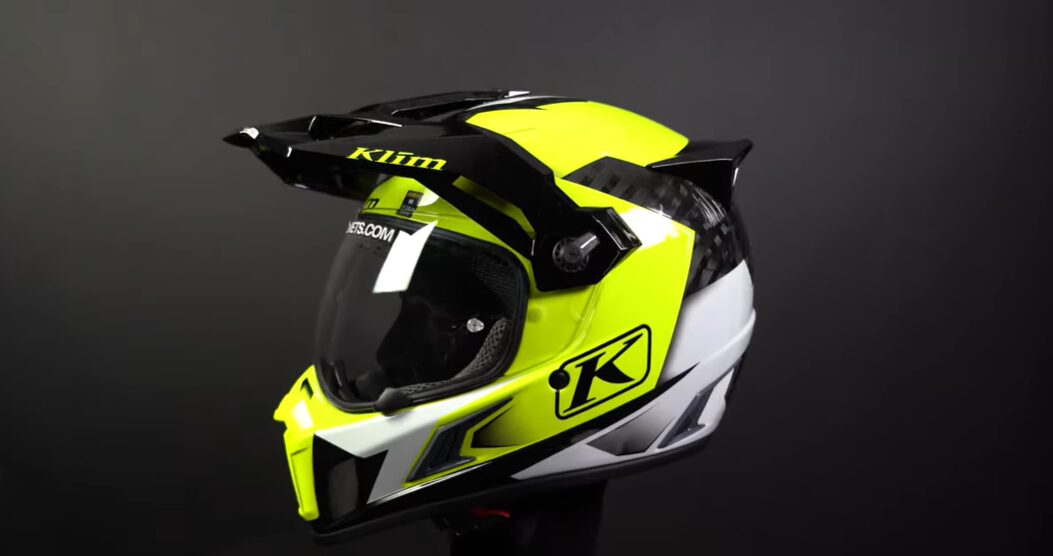
Highlight: Featherweight carbon shell with Koroyd impact protection; versatile for street-to-trail.
Helpful review:
After bouncing between a couple ADV lids, the Klim Krios Pro finally clicks for how I ride. It’s shockingly light, so neck fatigue basically disappeared on long highway days, and the Koroyd liner adds that extra impact tech without making it feel bulky. I run it most of the week with the shield and peak for commuting, then pop the shield off and throw on goggles for weekend gravel—swaps are quick and the big viewport makes both setups feel open.
The included photochromic shield (Transitions) is a huge quality-of-life upgrade: clear for early starts, then it darkens as the sun comes up, and the seal keeps out drizzle just fine. Venting is strong for a dual-sport: chin vent dries the visor, crown vents move real air, and the exhaust actually pulls heat once you’re above neighborhood speeds.
Fit is a true intermediate-oval with firm cheeks that broke in after two rides; no hot spots on my temples, and the speaker pockets took my comms without ear crush. On my ADV with a short screen, the peak stays stable if you angle it correctly—tilt it a notch down for sunrise/sunset and buffeting drops. It’s not library-quiet (it’s an ADV helmet), but with earplugs the noise is a calm rush at 70 mph.
The liner snaps out for a quick wash and dries fast, which matters after dusty rides. Hardware feels durable—peak screws haven’t backed out, and the carbon shell finish still looks new after a few bug-scrub sessions. If you want a helmet that’s truly comfortable on the slab but ready for dirt in minutes, this one nails the daily-to-adventure balance. — Sam J. Bay
8. Bell Moto-9S Flex (Off-Road)
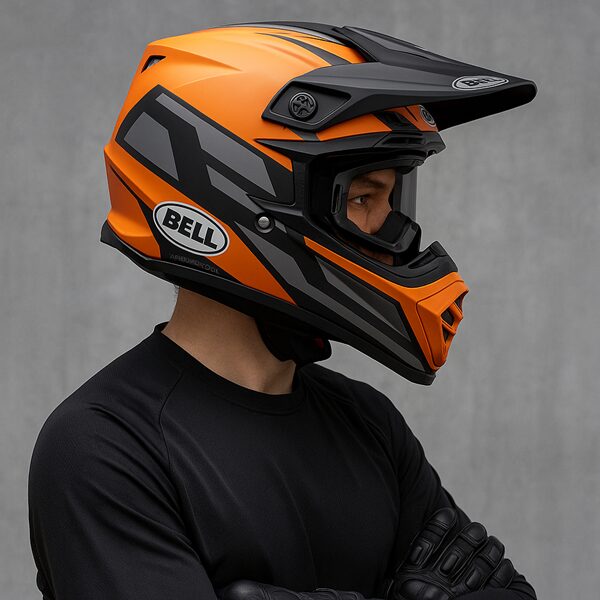
Highlight: Lightweight shell, three-layer Flex impact liner, and excellent ventilation for race-ready off-road comfort.
Helpful review:
My old dirt lid felt bulky and hot, so I upgraded to the Bell Moto-9S Flex. First ride at the local MX park and the difference was obvious—lighter feel, better balance in the air, and the Flex liner gives a snug, calm fit without hot spots. Roost guards and the peak do their job, and the airflow kept me clear-headed during slow technical sections and wide-open practice laps alike.
UNBOXING: Packed well, no scuffs. Comes with a soft bag and clear instructions for cheek-pad removal and visor adjustment.
FIT & COMFORT: True-to-size intermediate-oval fit with firm cheeks that break in by ride two. The segmented Flex liner gently conforms when you cinch the strap—secure without pressure points.
VENTILATION: Plenty of intake at the chin and brow with real exhaust out back. Sweat evaporates fast once you’re moving; foam in the chin bar also helps deflect dust while breathing hard.
GOGGLES & VISION: Wide eye port plays nicely with my 100% and Oakley goggles—no pinch, good seal, and the peak adjusts to block low sun without catching too much air.
SAFETY TECH: Bell’s Flex liner stacks three densities with a slip component to address low-, mid-, and high-energy impacts and rotational forces. Emergency-release cheek pads and a strong D-ring strap add peace of mind.
WEIGHT & BALANCE: Feels light on long motos and singletrack days. Neck and traps were fresher than with my previous composite helmet.
ISSUES: Peak screws can loosen after a few hard laps if you don’t snug them properly. Vent sliders are small with heavy gloves. Not the quietest on long dual-sport highway transfers (it’s a dirt helmet).
SOLUTION: Tiny dab of blue Loctite on the peak hardware after fit-up solved the loosening. I also keep a small multi-tool in my gear bag for quick visor tweaks.
MAINTENANCE: Liner and cheek pads pop out fast for washing; magnetic cheek-pad anchors make reinstallation easy. A quick microfiber wipe keeps the shell and peak clean after muddy sessions.
ACCESSORIES: Speaker recesses are minimal—fine for race-only, but if you dual-sport, mount a slim comms unit on the shell. Lots of third-party peaks and mouthpiece filters available.
BOTTOM LINE: Stable, airy, and confidence-inspiring. If you want a premium off-road lid with modern impact tech that stays cool when you’re working hard, the Moto-9S Flex delivers. — Robert Lee
9. Bell Custom 500 (Open-Face)

Highlight: Classic, low-profile style that’s lightweight and perfect for city rides and bike nights.
Helpful review: I’ve always loved the vintage look, and the Bell Custom 500 nails it without feeling like a toy. I was a little nervous swapping from a full-face, but for short hops, coffee runs, and summer evening cruises it’s been spot on. The shell is compact (no bobblehead), the liner is smoother than I expected, and the D-ring is old-school simple. Fit is intermediate-oval and runs true; I went snug so it breaks in to a firm, no-shake feel at 40–55 mph.
Out of the box it’s bare, so plan your setup. I gave it a good wipe, snapped on a 3-snap bubble shield for wind days, and keep a pair of sunglasses in the side bag for quick errands. If you ride at dusk, a short 3-snap peak helps with low sun. Earplugs are your friend—open-face is always breezier and louder than a full-face, and that’s kind of the point, but it keeps highway drone in check.
A couple tips from living with it: leave a little room around the forehead so the liner doesn’t hotspot; if you’re between sizes, the thinner/thicker cheek pads Bell sells can fine-tune the seal. In rain, the bubble shield sheds water better than glasses alone. For colder mornings, I throw on a neck tube and it’s surprisingly comfortable into the mid-50s.
Downsides? It’s still an open-face—more wind, more bugs, and less protection than a chin-bar lid. The snaps on aftermarket visors can be tight the first few times, and at 65+ mph you’ll want a face shield to cut the blast. Otherwise, the paint and trim have held up great, and the compact look gets compliments every ride. If you want that classic vibe with modern comfort for urban rides and mellow cruises, the Custom 500 hits the sweet spot. — Karin Melcher
10. Bell Pit Boss (Half Helmet)
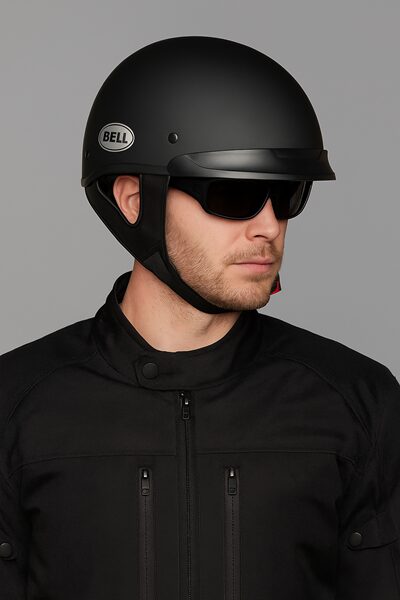
Highlight: Lightweight half-helmet with micro-adjust fit and drop-down sun visor—perfect for city cruises.
Helpful review:
I picked up the Bell Pit Boss for quick rides and errands when I don’t want a full-face. The big win is the Speed Dial micro-adjust system at the back: twist it and the helmet cinches evenly so it doesn’t lift at 45–60 mph. It feels compact (no bobblehead), the D-ring is simple, and the integrated drop-down visor keeps sun and wind in check without needing sunglasses.
Out of the box it’s plug-and-play. I gave it a quick wipe, set the dial to snug, and the fit settled after a couple rides. The removable neck curtain is great on cooler mornings—snaps on in seconds and even has room for slim speakers if you run a comms unit. Venting is, well, half-helmet levels—lots of breeze, which is exactly what I wanted for summer rides.
Notes from living with it: if you’re between sizes, go snug; the dial gives you extra range without hotspots. The sun visor drops far enough for most faces, but I still carry clear glasses for night. Finish and trim have held up after a few bug-cleanings, and the low profile draws fewer “mushroom” comments than other half lids I’ve tried.
Downsides? It’s still a half-helmet—more wind and less overall protection than a full-face or even a 3/4. Above 65 mph the wind noise ramps up (earplugs help). The visor isn’t photochromic, and very bright days might call for darker eyewear. For relaxed city rides, beach runs, and bike-night hops, though, the Pit Boss nails the easy, lightweight vibe. — R. Cole
Wearing the Right Motorcycle Helmet: Shape, Size, Style & Safety Ratings [3]
Choosing a helmet isn’t just about looks—it’s about matching your head shape, size, style, and safety rating so it protects you when it counts.
1) Shape (Round, Intermediate-Oval, Long-Oval)
What to check: Pressure points on forehead/sides/back after 10–15 minutes.
Why it matters: A shape mismatch creates hot spots, headaches, and slippage, which can rotate or eject the helmet in a crash.
2) Size (Snug, Not Painful)
What to check: Use a soft tape above eyebrows; compare to the brand’s size chart. With cheek pads, you should feel firm contact; helmet shouldn’t roll off when you pull up from the rear.
Why it matters: Too loose = energy not managed, helmet can twist; too tight = fatigue and distraction. Correct size keeps the liner where it must be to absorb impact.
3) Style (Full-Face, Modular, ADV, Open-Face)
What to check: Your riding type and environment—speed, weather, dirt vs. street, commuting vs. touring.
Why it matters: Full-face offers the best chin and face protection; modular adds convenience; ADV improves ventilation/peaks for off-road; open-face trades protection for visibility and airflow.
4) Safety Ratings (DOT, ECE, Snell, FIM)
What to check: Certification label and the model’s test standard.
Why it matters: These ratings indicate impact, penetration, and retention performance thresholds. Prioritize modern standards (e.g., ECE 22.06, Snell M2020) for better rotational and multi-impact considerations.
Quick Fit Test
- Wear 10–15 minutes → no sharp pressure points
- Shake test → minimal movement
- Vision clear; strap snug (two-finger rule)
Bottom line: Start with shape, lock in size, pick the style for your riding, and confirm safety ratings—in that order.
Conclusion
After testing all 10 helmets, I can confidently say that there’s no single “best” helmet—only the best one for your riding style, budget, and head shape. From the everyday reliability of the Shoei RF-1400, to the track-focused precision of the AGV Pista GP RR and Arai Corsair-X, each model serves its purpose. My advice remains the same: fit and certification matter most. A helmet should feel like part of you, not just gear. Choose wisely, and your helmet will not only make your rides more comfortable but may also save your life when it matters most.
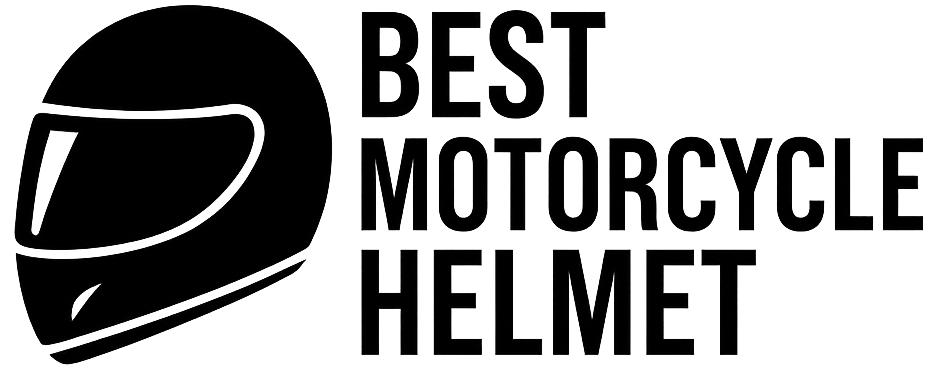
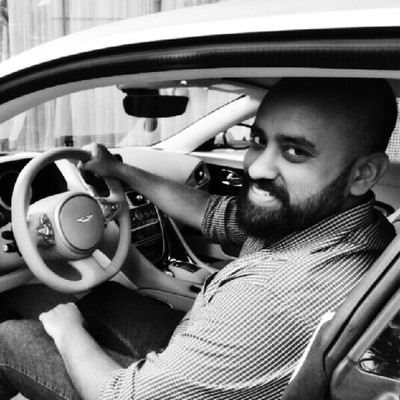
I love helmets with cool graphics, but I’ve noticed they can be more expensive than plain colors. Do they offer the same protection, or is it just paying more for the design?
I’ve been riding for 5 years, and I think weight makes a huge difference. My old helmet was heavy and gave me neck pain. After switching to a lighter composite shell, my rides are much easier.
How often should a helmet actually be replaced? I’ve heard some people say every 3 years, others say 5 years unless there’s damage. What’s the truth?
Do Bluetooth-integrated helmets work well for phone calls and GPS directions? I’m considering one, but I’m worried about battery life on long trips.
What’s the best helmet for long-distance touring? I ride 6–8 hours on weekends and my current helmet gets really uncomfortable after 2 hours. Any recommendations from experienced riders?
There are several models and brands. Can you let me know what your budget is so I can give you suggestion.
Best Regards,
I used to ride with an open-face helmet because I liked the airflow, but after seeing a friend’s accident, I switched to full-face. Honestly, the peace of mind is worth the extra heat.
I recently bought a helmet with an internal sun visor. Honestly, I can’t ride without it now. Anyone else prefer helmets with built-in visors over carrying sunglasses?
Glad to know you love helmets built-in visors. It is one of the safest ones I think.
My helmet fogs up a lot during cold mornings in Alaska. I’ve tried anti-fog sprays, but they don’t last long. Does anyone recommend a pinlock visor?
I’ve been using a modular helmet for commuting, but I’m not sure if it’s as safe as a full-face one. Has anyone here switched from modular to full-face? Did you notice a big difference in noise and comfort?
Each has its own advantages and disadvantages. Choose the one that fits your needs like budget, comfort, size, but don’t forget about the popular brands and quality to protect yourself when riding.
I crashed once while wearing a budget helmet, and it saved me from serious injury. After that, I decided never to compromise on safety. Spending extra for DOT or ECE certified helmets is worth it.
I am glad you are safe. Make sure you don’t forget to bring your “hero” with you when riding.